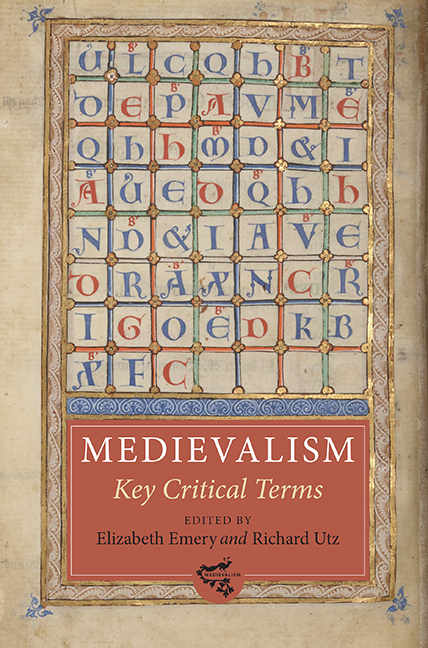Book contents
- Frontmatter
- Dedication
- Contents
- List of Illustrations
- List of Contributors
- Making Medievalism: A Critical Overview
- 1 Archive
- 2 Authenticity
- 3 Authority
- 4 Christianity
- 5 Co-disciplinarity
- 6 Continuity
- 7 Feast
- 8 Genealogy
- 9 Gesture
- 10 Gothic
- 11 Heresy
- 12 Humor
- 13 Lingua
- 14 Love
- 15 Memory
- 16 Middle
- 17 Modernity
- 18 Monument
- 19 Myth
- 20 Play
- 21 Presentism
- 22 Primitive
- 23 Purity
- 24 Reenactment
- 25 Resonance
- 26 Simulacrum
- 27 Spectacle
- 28 Transfer
- 29 Trauma
- 30 Troubadour
- Index
- Medievalism
19 - Myth
Published online by Cambridge University Press: 08 October 2022
- Frontmatter
- Dedication
- Contents
- List of Illustrations
- List of Contributors
- Making Medievalism: A Critical Overview
- 1 Archive
- 2 Authenticity
- 3 Authority
- 4 Christianity
- 5 Co-disciplinarity
- 6 Continuity
- 7 Feast
- 8 Genealogy
- 9 Gesture
- 10 Gothic
- 11 Heresy
- 12 Humor
- 13 Lingua
- 14 Love
- 15 Memory
- 16 Middle
- 17 Modernity
- 18 Monument
- 19 Myth
- 20 Play
- 21 Presentism
- 22 Primitive
- 23 Purity
- 24 Reenactment
- 25 Resonance
- 26 Simulacrum
- 27 Spectacle
- 28 Transfer
- 29 Trauma
- 30 Troubadour
- Index
- Medievalism
Summary
“MYTH” IS A controversial term, especially in respect of medievalism, for retrospective interpretations placed on medieval and pre-medieval cultural products are often colored by contemporary political and ideological agendas. In order to avoid any confusion with continuing, institutionalized credos, in this essay “myth” is applied to signify defunct belief systems, whereas the term “religion” is used to refer to extant belief systems: in this case, Christianity. The main focus will be on the successive medievalisms involved in the reception history of Old Norse myths. Some brief introductory remarks concerning European mythological systems during the Christian conversion period will help to provide a broad context.
The legitimization of Christianity by the Roman emperor Constantine in the early fourth century, then its adoption as the official religion of the Roman Empire in the late fourth century, greatly facilitated its northward spread. As Christianity carried with it Greek and Latin learning, it was mainly in this way that Greco-Roman classical literature and its associated mythology survived the fall of the Roman Empire in the late fifth century and became esteemed throughout medieval Europe. By contrast, European mythological systems, which came into contact with Christian missions in the early medieval period, were the products of non-literate cultures, and relations between followers of these mythologies and Christianity's messengers frequently involved violence, including the destruction of sacred pagan sites.
Apart from what was written by contemporary Roman and Christian commentators, much of what we now know about the mythological beliefs of the Celtic, Slavic, and Germanic tribes is due to the linguistic and philological recovery period beginning in the nineteenth century. Our knowledge of Finnish mythology is almost entirely due to nineteenth-century recovery projects. Inevitably, the reconstruction of mythologies during periods that were far removed from the times in which they were societally current raises questions about whether authenticity was achievable or even if that was the main intention. The medievalism in such cases is typically improvisational and romanticized. In respect of Old Norse mythology, however, matters were somewhat different, in as much as manuscripts concerning Scandinavian myths and legends set down in the Middle Ages were plentiful and increasingly available to scholars from a much earlier date.
- Type
- Chapter
- Information
- Medievalism: Key Critical Terms , pp. 165 - 172Publisher: Boydell & BrewerPrint publication year: 2014
- 1
- Cited by

